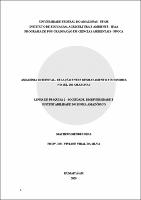| ???jsp.display-item.social.title??? |


|
Please use this identifier to cite or link to this item:
https://tede.ufam.edu.br/handle/tede/11198Full metadata record
| DC Field | Value | Language |
|---|---|---|
| dc.creator | Nina, Matheus Mendes | - |
| dc.creator.Lattes | http://lattes.cnpq.br/9505355922812341 | eng |
| dc.contributor.advisor1 | Silva, Viviane Vidal da | - |
| dc.contributor.advisor1Lattes | http://lattes.cnpq.br/4787853604608970 | eng |
| dc.contributor.referee1 | Herraiz, Aurélio Diaz | - |
| dc.contributor.referee1Lattes | http://lattes.cnpq.br/8473161193314003 | eng |
| dc.contributor.referee2 | Silva, Douglas Marcelo Pinheiro da | - |
| dc.contributor.referee2Lattes | http://lattes.cnpq.br/6219916883682579 | eng |
| dc.date.issued | 2025-07-14 | - |
| dc.identifier.citation | NINA, Matheus Mendes. Amazônia Ocidental: relação entre desmatamento e economia no Sul do Amazonas. 2025. 77 f. Dissertação (Mestrado em Ciências Ambientais) - Universidade Federal do Amazonas, Humaitá (AM), 2025. | eng |
| dc.identifier.uri | https://tede.ufam.edu.br/handle/tede/11198 | - |
| dc.description.resumo | Esta dissertação analisou a inter-relação entre desmatamento e variáveis socioeconômicas nos municípios da mesorregião sul do Amazonas ao longo de 25 anos (1999–2024). Partindo do contexto da Amazônia Legal e do “Arco do Desmatamento”, destaca-se a intensificação da fronteira agrícola impulsionada pela abertura de ramais a partir das rodovias Transamazônica (BR-230) e Manaus–Porto Velho (BR-319) e pelo crescimento de atividades agropecuárias e madeireiras . O objetivo geral foi testar a hipótese de que o desmatamento está associado ao crescimento econômico local, medido pelo PIB per capita, rebanho bovino, extração de madeira e investimentos na agricultura e pecuária . Adotou-se abordagem mista, com coleta de séries temporais de 1999 a 2024 em fontes como MapBiomas, IBGE/SIDRA, BCB e IBAMA, seguida de Análise de Componentes Principais (PCA) sobre matriz de correlação de Pearson para identificar padrões latentes de covariância entre desmatamento e variáveis socioeconômicas . Os resultados revelaram três ciclos distintos: (1) forte avanço predatório até 2007; (2) contenção entre 2008 e 2012 devido ao PPCDAm; e (3) nova explosão de desmate a partir de 2013, reforçada pelas flexibilizações do Novo Código Florestal e fragilização de órgãos de fiscalização, culminando em pico entre 2019 e 2024 . Conclui-se que há sinergia significativa entre crescimento socioeconômico e pressão sobre a floresta, exigindo recomposição urgente das bases estatais de fiscalização e reorientação de políticas territoriais para modelos de economia de baixo impacto. A continuidade desse padrão, se não revertida, comprometerá a sustentabilidade ambiental e a geração de renda das comunidades locais. | eng |
| dc.description.abstract | This dissertation analyzed the interrelationship between deforestation and socioeconomic variables in the municipalities of the southern mesoregion of Amazonas over a 25-year period (1999–2024). Within the context of the Legal Amazon and the “Deforestation Arc,” it highlights the intensification of the agricultural frontier driven by the opening of access roads from the Trans-Amazonian Highway (BR-230) and the Manaus–Porto Velho Highway (BR-319), as well as the growth of agricultural and logging activities. The general objective was to test the hypothesis that deforestation is associated with local economic growth, measured by GDP per capita, cattle herd size, timber extraction, and investments in agriculture and livestock. A mixed-methods approach was adopted, with time-series data collected from 1999 to 2024 from sources such as MapBiomas, IBGE/SIDRA, the Central Bank of Brazil, and IBAMA, followed by Principal Component Analysis (PCA) on a Pearson correlation matrix to identify latent patterns of covariance between deforestation and socioeconomic variables. The results revealed three distinct cycles: (1) a strong predatory advance up to 2007; (2) containment between 2008 and 2012 due to the PPCDAm; and (3) a new surge in deforestation from 2013 onward, reinforced by the flexibilizations of the New Forest Code and the weakening of oversight agencies, culminating in a peak between 2019 and 2024. It is concluded that there is a significant synergy between socioeconomic growth and pressure on the forest, requiring an urgent restoration of state enforcement capacities and a reorientation of territorial policies toward low-impact economic models. If this pattern is not reversed, it will compromise both environmental sustainability and the income generation of local communities. | eng |
| dc.description.sponsorship | FAPEAM - Fundação de Amparo à Pesquisa do Estado do Amazonas | eng |
| dc.format | application/pdf | * |
| dc.thumbnail.url | https://tede.ufam.edu.br/retrieve/88155/DISS_MatheusNina_PPGCA.jpg | * |
| dc.language | por | eng |
| dc.publisher | Universidade Federal do Amazonas | eng |
| dc.publisher.department | Instituto de Educação, Agricultura e Ambiente - Humaitá | eng |
| dc.publisher.country | Brasil | eng |
| dc.publisher.initials | UFAM | eng |
| dc.publisher.program | Programa de Pós-Graduação em Ciências Ambientais | eng |
| dc.rights | Acesso Aberto | - |
| dc.rights.uri | https://creativecommons.org/licenses/by-nc-nd/4.0/ | pt_BR |
| dc.subject | Desmatamento - Amazônia | por |
| dc.subject | Sustentabilidade e meio ambiente - Conservação | por |
| dc.subject | Desenvolvimento sustentável - Pesquisa | por |
| dc.subject.cnpq | CIENCIAS AGRARIAS: RECURSOS FLORESTAIS E ENGENHARIA FLORESTAL | eng |
| dc.title | Amazônia Ocidental: relação entre desmatamento e economia no Sul do Amazonas | eng |
| dc.type | Dissertação | eng |
| dc.contributor.advisor1orcid | http://orcid.org/0000-0002-0887-7523 | eng |
| dc.creator.orcid | https://orcid.org/0000-0002-5107-6123 | eng |
| dc.contributor.referee1orcid | https://orcid.org/0000-0002-7856-0388 | eng |
| dc.contributor.referee2orcid | https://orcid.org/0000-0003-3422-1576 | eng |
| dc.subject.user | Desmatamento | por |
| dc.subject.user | Ordenamento territorial | por |
| dc.subject.user | Fronteira agrícola | por |
| dc.subject.user | Análise de Componentes Principais | por |
| dc.subject.user | Políticas Ambientais | por |
| dc.subject.user | Sul do Amazonas | por |
| Appears in Collections: | Mestrado em Ciências Ambientais | |
Files in This Item:
| File | Description | Size | Format | |
|---|---|---|---|---|
| DISS_MatheusNina_PPGCA | 1.81 MB | Adobe PDF |  Download/Open Preview |
Items in DSpace are protected by copyright, with all rights reserved, unless otherwise indicated.




